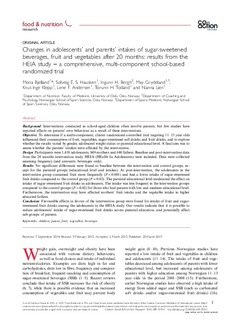| dc.contributor.author | Bjelland, Mona | |
| dc.contributor.author | Hausken, Solveig E. Sand | |
| dc.contributor.author | Bergh, Ingunn Holden | |
| dc.contributor.author | Grydeland, May | |
| dc.contributor.author | Klepp, Knut Inge | |
| dc.contributor.author | Andersen, Lene F. | |
| dc.contributor.author | Totland, Torunn Holm | |
| dc.contributor.author | Lien, Nanna | |
| dc.date.accessioned | 2016-04-06T07:25:58Z | |
| dc.date.available | 2016-04-06T07:25:58Z | |
| dc.date.issued | 2015-03-20 | |
| dc.identifier.citation | Food & Nutrition Research 2015, 59, 25932. doi: http://dx.doi.org/10.3402/fnr.v59.25932 | nb_NO |
| dc.identifier.uri | http://hdl.handle.net/11250/2384089 | |
| dc.description | © 2015 Mona Bjelland et al. This is an Open Access article distributed under the terms of the Creative Commons Attribution 4.0 International License (http://creativecommons.org/licenses/by/4.0/), allowing third parties to copy and redistribute the material in any medium or format and to remix, transform, and build upon the material for any purpose, even commercially, provided the original work is properly cited and states its license. | nb_NO |
| dc.description.abstract | Background: Interventions conducted in school-aged children often involve parents, but few studies have reported effects on parents’ own behaviour as a result of these interventions.
Objective: To determine if a multi-component, cluster randomized controlled trial targeting 11–13 year olds influenced their consumption of fruit, vegetables, sugar-sweetened soft drinks and fruit drinks, and to explore whether the results varied by gender, adolescent weight status or parental educational level. A final aim was to assess whether the parents’ intakes were affected by the intervention.
Design: Participants were 1,418 adolescents, 849 mothers and 680 fathers. Baseline and post-intervention data from the 20 months intervention study HEIA (HEalth In Adolescents) were included. Data were collected assessing frequency (and amounts; beverages only).
Results: No significant differences were found at baseline between the intervention and control groups, except for the parental groups (educational level and intakes). At post-intervention, the adolescents in the intervention group consumed fruit more frequently (P<0.001) and had a lower intake of sugar-sweetened fruit drinks compared to the control group (P=0.02). The parental educational level moderated the effect on intake of sugar-sweetened fruit drinks in adolescents. The intake was less frequent in the intervention groups compared to the control groups (P=0.02) for those who had parents with low and medium educational level. Furthermore, the intervention may have affected mothers’ fruit intake and the vegetable intake in higher educated fathers.
Conclusion: Favourable effects in favour of the intervention group were found for intake of fruit and sugar-sweetened fruit drinks among the adolescents in the HEIA study. Our results indicate that it is possible to reduce adolescents’ intake of sugar-sweetened fruit drinks across parental education, and potentially affect sub-groups of parents. | nb_NO |
| dc.language.iso | eng | nb_NO |
| dc.subject | children | nb_NO |
| dc.subject | parent | nb_NO |
| dc.subject | fruit | nb_NO |
| dc.subject | vegetables | nb_NO |
| dc.subject | beverages | nb_NO |
| dc.title | Changes in adolescents’ and parents’ intakes of sugar-sweetened beverages, fruit and vegetables after 20 months: results from the HEIA study a comprehensive, multi-component school-based randomized trial | nb_NO |
| dc.type | Journal article | nb_NO |
| dc.type | Peer reviewed | nb_NO |
| dc.subject.nsi | VDP::Medical disciplines: 700 | nb_NO |
| dc.subject.nsi | VDP::Medical disciplines: 700::Health sciences: 800 | nb_NO |
| dc.source.journal | Food & Nutrition Research (FNR) | nb_NO |
| dc.description.localcode | Seksjon for coaching og psykologi / Department of Coaching and Psychology | nb_NO |
